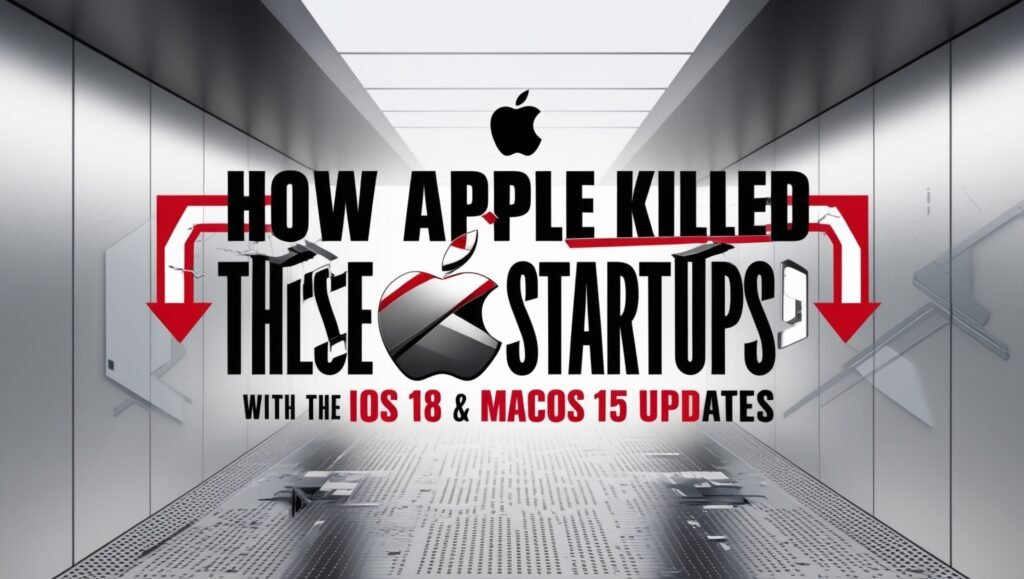In the world of technology, few companies command attention and influence like Apple. With each software update they release, the company has the potential to reshape entire markets and industries. In 2024, Apple launched iOS 18 and macOS 15, updates that not only enhanced its products but also unintentionally dismantled several startups that had carved niches in the market. In this article, we will explore how these updates impacted various startups and what this means for competition in the tech landscape.

Understanding Apple’s Influence
Apple’s influence stretches far beyond its loyal customer base. With millions of users worldwide, changes to its operating systems can lead to significant shifts in market dynamics. New features, performance improvements, and integrations can create challenges for smaller companies that rely on the Apple ecosystem to thrive.
As Apple rolls out new updates, startups often find themselves at a crossroads. They can either innovate rapidly to adapt or face the harsh reality of obsolescence. Let’s dive into some notable startups affected by the recent iOS 18 and macOS 15 updates.
1. UpNote: Competitive Note-Taking Applications
The Startup
UpNote was gaining traction as a versatile note-taking app, designed to help users organize their thoughts seamlessly. With features like rich text editing, cloud syncing, and advanced search capabilities, it quickly appealed to users seeking a robust alternative to Apple Notes.
The Change
With the introduction of iOS 18, Apple significantly enhanced Apple Notes, incorporating features such as collaborative writing, advanced tagging, and document scanning. These features were similar to UpNote’s offerings, but backed by the robust security and integration of the Apple ecosystem.
The Impact
This forced UpNote to reconsider its approach to user engagement and feature development. Although UpNote has a dedicated user base, it found itself competing against a free, built-in option that is continuously updated with no additional costs for users. As a result, many potential users opted for Apple Notes, leading to a decline in UpNote’s downloads and user engagement.
2. Shazam: Music Recognition Apps
The Startup
Shazam revolutionized the way people interact with music. Its ability to identify songs quickly made it a staple among music lovers. While it was acquired by Apple back in 2018, several smaller competitors tried to carve out their space in a market dominated by Shazam.
The Change
With the release of macOS 15 and iOS 18, Apple integrated song identification directly into Siri. Users can now ask Siri to identify a song playing in the background without the need for a dedicated app. This capability was further improved, allowing users to hear song previews instantly.
The Impact
The integration of song identification into Siri has put additional pressure on smaller competitors like SoundHound and Musixmatch. With Apple’s vast reach and resources, the convenience of a built-in feature became more appealing than downloading another app. Consequently, these startups faced declining user retention and investment challenges.
3. Canva: Graphic Design Tools
The Startup
Canva has transformed the graphic design landscape, providing a user-friendly platform for individuals and businesses to create high-quality designs. Its strength lies in its accessibility, catering to users with no design experience.
The Change
With iOS 18 and macOS 15, Apple introduced enhanced features in Keynote and Pages, including advanced graphic design functionalities such as templates, image editing, and real-time collaboration. Additionally, the integration of Apple Pencil features for drawing and sketching provided users with more native options for design.
The Impact
Canva now faced tough competition from Apple’s updated productivity applications that offered free, integrated tools for design work. While Canva is still a powerful tool, user migration to Apple’s free apps means that Canva may need to explore other differentiating features to maintain its user base, particularly in educational institutions where many began using Apple devices for learning.
4. Strava: Fitness and Activity Tracking
The Startup
Strava emerged as a popular app for fitness enthusiasts, allowing users to track their running, cycling, and other athletic endeavors. Its social features fostered community interactions, encouraging users to share workouts and achievements.
The Change
With the launch of iOS 18 and macOS 15, Apple significantly improved the Fitness app. It introduced real-time activity sharing, in-app coaching, and the ability to sync with Apple Watch’s precise health metrics and fitness tracking tools.
The Impact
The updates compelled Strava users to weigh the benefits of using a dedicated fitness app against the comprehensive features of Apple’s built-in Fitness app. Strava’s premium offering may not be enough to compete with a feature set that comes free with the device. Consequently, Strava saw a slowdown in new user acquisitions and faced increasing challenges in retaining existing customers.
5. HelloFresh: Meal Kit Delivery Services
The Startup
HelloFresh gained popularity as a meal kit delivery service, catering to users looking for convenience in meal preparation. Its competitive pricing and variety made it a household name in meal delivery.
The Change
With the introduction of iOS 18’s Apple Food, users can now access personalized recipe suggestions based on their dietary preferences directly within the Apple ecosystem. The app uses machine learning to recommend meals, utilizing user feedback and integrated shopping lists.
The Impact
HelloFresh faced increased competition due to the convenience and personalization of Apple’s offerings. With meal planning integrated into users’ daily digital environments, HelloFresh needed to navigate a more competitive landscape, focusing on niche markets to maintain growth while managing operational costs.
6. Dropbox: Cloud Storage Solutions
The Startup
Dropbox was among the first players in the cloud storage market, providing users with easy ways to store and share files. Its collaborative features and cross-platform access made it a go-to solution.
The Change
Apple’s iCloud Drive improvements in macOS 15 and iOS 18 included better integration with files and apps across devices and innovative sharing capabilities that were once distinctive to services like Dropbox. Users now enjoy seamless sharing within the Apple ecosystem without needing a third-party application.
The Impact
Many users reevaluated their subscriptions to third-party cloud storage, particularly those heavily invested in Apple’s ecosystem. This shift likely diminished Dropbox’s user base, prompting the company to rethink its competitive strategies.
7. Slack: Team Collaboration Tools
The Startup
Slack revolutionized team communications by offering a platform for messaging, file sharing, and integration with other productivity tools. It quickly became the go-to solution for remote teams.
The Change
With the recent updates, Apple’s Messages app extended its functionality to serve as a collaboration tool for businesses. Features like shared channels, task management capabilities, and video conferencing capabilities have streamlined communication in a single interface.
The Impact
The expansion of Apple’s native messaging app created new challenges for established services like Slack. As users shifted to Apple’s collaboration offerings, Slack found it increasingly difficult to justify its premium features. This has required Slack to innovate continuously, introduce user-friendly integrations, and provide value that Apple’s free offering could not.
How Small Companies Can Survive
While the onslaught of powerful updates from Apple can be daunting, startups can take proactive measures to adapt and thrive.
1. Innovation and Differentiation
Startups must continue to innovate and provide unique offerings that Apple doesn’t cover. This includes focusing on niche markets or developing features that enhance user experience.
2. Community Building
Engaging with users builds brand loyalty and community, which can be vital in retaining users who may consider switching to Apple’s integrated offerings.
3. Strategic Partnerships
By integrating services or forming alliances with other startups, a company can enhance its value proposition, creating an ecosystem that stands against Apple’s offerings.
4. Leveraging Feedback
Startups should actively solicit user feedback. Understanding consumer needs can guide product improvements and help companies remain in tune with market demands.

Conclusion
The launch of iOS 18 and macOS 15 not only embodied Apple’s continuous innovation but also illustrated the stark realities startups face in the tech industry. The pressure from a giant like Apple can significantly disrupt smaller companies that lack the resources to compete at that level.
While it is challenging, it is not insurmountable. Startups can survive and even thrive by focusing on differentiation, community engagement, and strategic innovation to carve out their niches amid competition. They should adapt, learn, and innovate continually in a landscape that is ever-changing, making the most of the challenges Apple presents.
Further Reading
For developers looking to navigate these challenges or keep up with the latest trends, consider joining technology hubs and communities that discuss the impact of tech updates. Check out TechCrunch for insights on technology trends and more news about how companies can maneuver the competitive landscape influenced by giants like Apple.




Your point of view caught my eye and was very interesting. Thanks. I have a question for you.